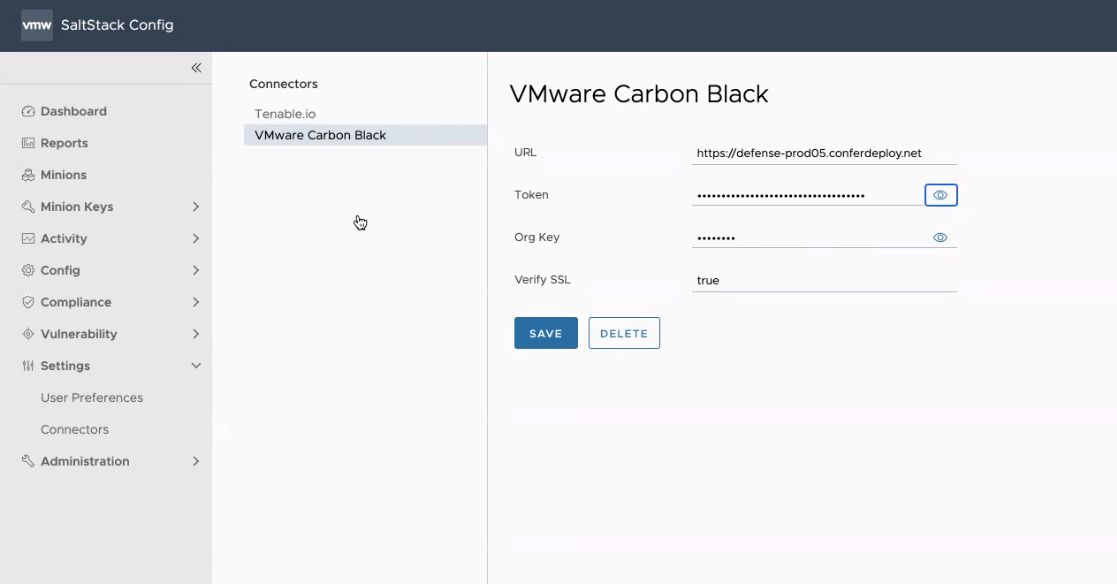As an alternative to running an assessment on a vulnerability policy, SaltStack SecOps Vulnerability supports importing security scans generated by a variety of third-party vendors.
Instead of running an assessment on a vulnerability policy, you can import a third-party security scan directly into SaltStack Config and remediate the security advisories it identified using SaltStack SecOps Vulnerability. See How do I run a vulnerability assessment for more information about running a standard assessment.
- Tenable
- Rapid7
- Qualys
- Kenna Security
- Carbon Black
After importing your scan, the Import Staging workspace displays an import summary and two tables: a list of Supported Vulnerabilities and a list of Unsupported Vulnerabilities. Supported vulnerabilities are the advisories that are available for remediation. Unsupported vulnerabilities are the advisories that cannot currently be remediated. The list of unsupported vulnerabilities includes an explanation of why they cannot be imported.
You can import a third-party from a file, from a connector, or by using the command line.
Prerequisites
Before you can import a third-party security scan you must configure a connector. The connector must first be configured using the third-party tool's API keys.
To configure a Tenable.io connector:

| Connector field | Description |
|---|---|
| Secret Key and Access Key | Key pair required to authenticate with the connector API. For more information on generating your keys, see the Tenable.io documentation. |
| URL | Base URL for API requests. This defaults to https://cloud.tenable.com. |
| Days since | Query Tenable.io scan history beginning this number of days ago. Leave blank to query an unlimited period of time. When you use a connector to import scan results, SaltStack SecOps Vulnerability uses the most recent results per node available within this period.
Note: To ensure your policy contains the latest scan data, make sure to rerun your import after each scan.
SaltStack SecOps Vulnerability does not poll Tenable.io for the latest scan data automatically.
|
To configure a Carbon Black connector (Windows only):

Before you can configure a Carbon Black connector, you must first set up a Windows Minion Carbon Black sensor kit environment.
- Launch a Saltstack Config environment and deploy a Windows server.
- Install the Salt minion on the Windows server. For more information see, Salt Minion Installation.
- Accept the master keys in SaltStack Config, and the minion keys from SaltStack Config or the Salt Master.
- Install the Carbon Black sensor kit on the Windows minion. For more information, see Installing Sensors on VM Workloads.
- In SaltStack SecOps, define a policy with a target group that contains the Windows minion.
- After the SaltStack Config VMan ingestion is complete, sync the SaltStack Config Carbon Black module from the Salt master by running these commands:
salt mywindowsminion saltutil.sync_modules saltenv=sse. - On the Windows minion, set the Carbon Black device grain by running the
salt mywindowsminion carbonblack.set_device_grain.
| Connector Field | Description |
|---|---|
| URL | URL for API requests |
| Token and Org Key | Key pair required to authenticate with the connector API.
Note: If you a delete a VMware Carbon Black connector, these fields are populated with 'xxxx' characters. This is to maintain the token key format of 'xxxxxxxxxxxxxxxxxxxxxxxx/xxxxxxx'

|
| Verify SSL | Default is set to true. |
- Click Minions and select either All Minions or a specific minion for a policy target group.
- Click Run Command and run these commands:
saltutil.sync_all,carbon_black.set_device_grain, andsaltutil.refresh_grains.
Procedure
Results
The selected advisories are imported to SaltStack SecOps Vulnerability and appear as an assessment in the policy dashboard. The policy dashboard also displays Imported from under the policy title to indicate that the latest assessment was imported from your third-party tool.
What to do next
You can now remediate these advisories. See How do I remediate my advisories for more information.

